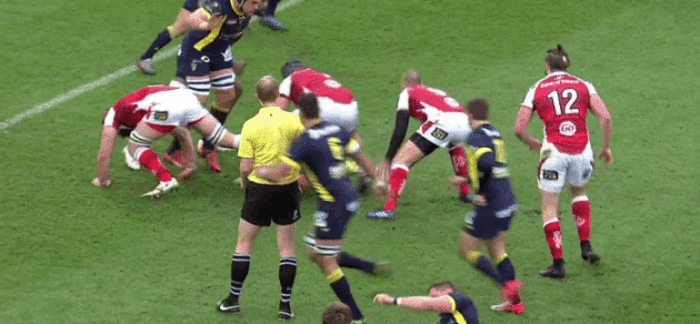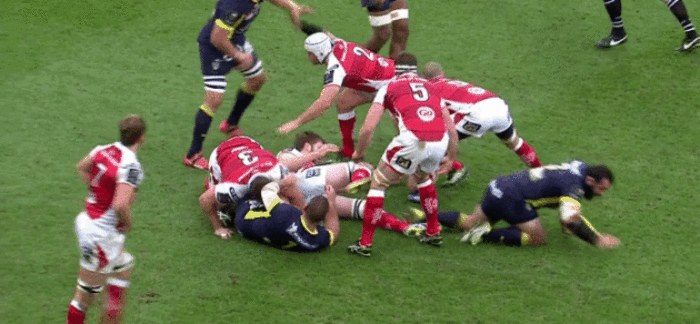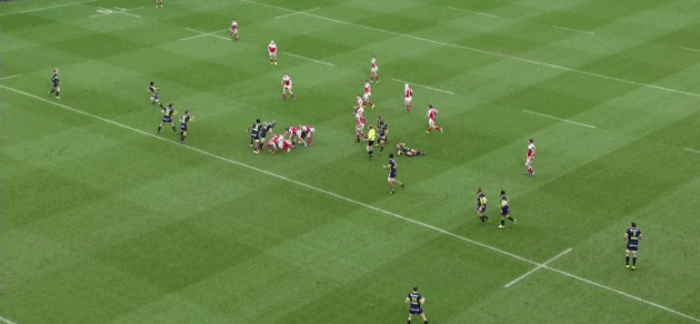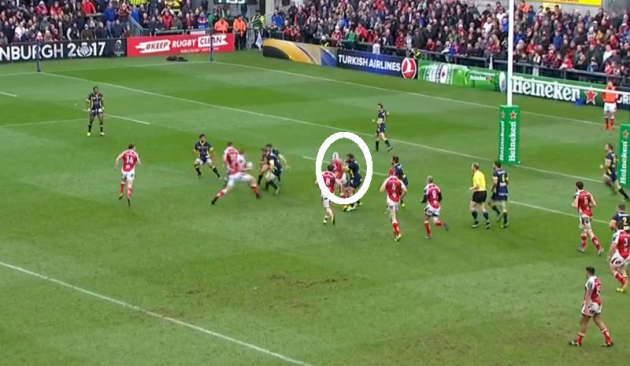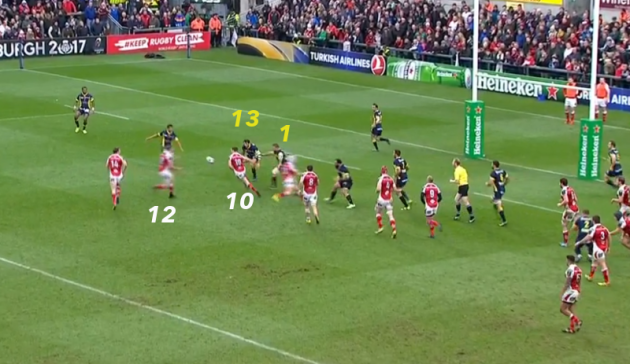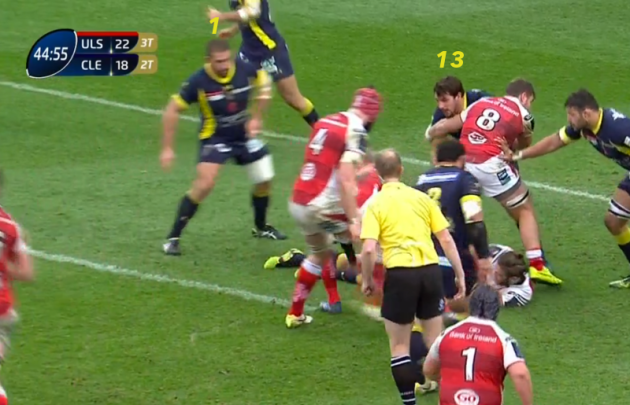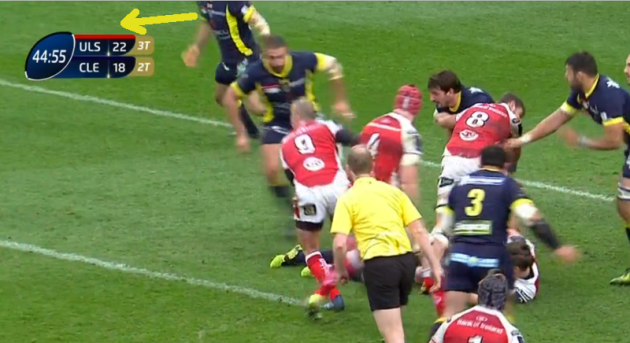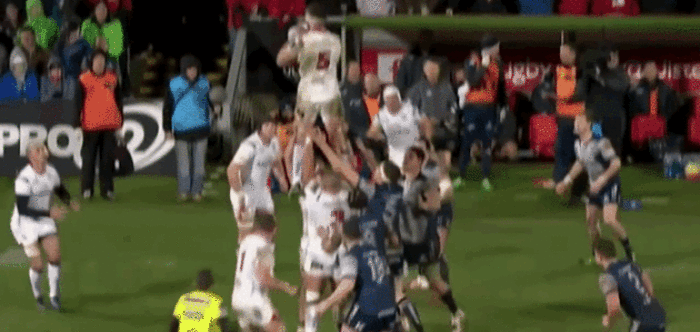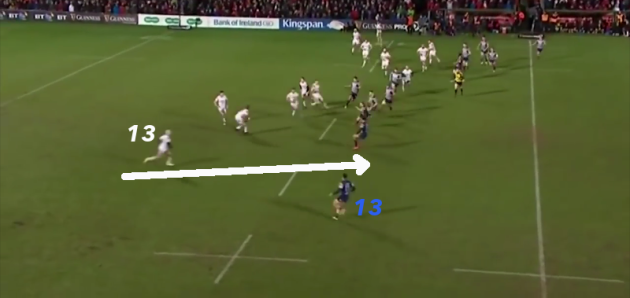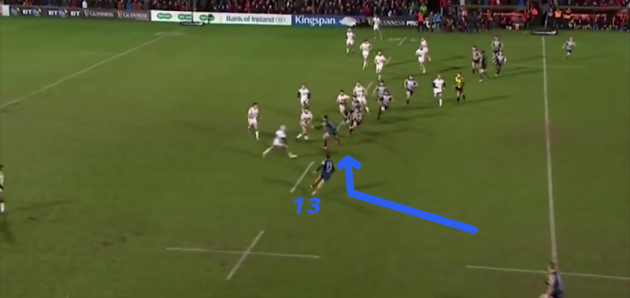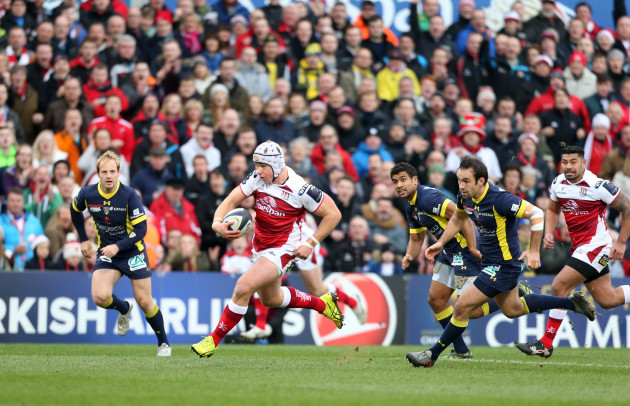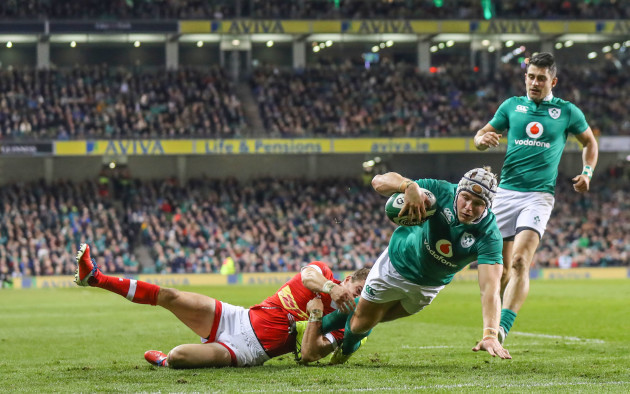LUKE MARSHALL HAS been running some superb lines this season.
Perhaps the standout moment in this regard came during Ulster’s 39-32 win over Clermont at Kingspan Stadium in the Champions Cup last month.
On first viewing, it seems rather simple from Marshall. And it is rather simple, but cleverly done.
The 25-year-old talks us through the score below, pointing out the important details that allowed him to break through the Clermont defence. It begins with the nature of Ulster’s possession in this instance.
“I’m looking at the phase before, if we get over the gainline, which means their defensive line is going to be pushed back,” explains Marshall.
So let us do what the Ulster midfielder did, and look at the phase before he scores.
A Stuart McCloskey offload allows Sean Reidy to pirouette out of Camille Lopez’s tackle attempt and surge forward into Peceli Yato, right over the gainline and with a clean presentation of the ball to follow.
Exactly what any backline wants: clean and quick ball beyond the gainline. Marshall’s brain is already computing the possibilities.
“You’re looking at the body movement of the defenders against you,” says Marshall. “In that instance, one of their centres was looking in and one was looking out. They sort of got detached from each other and that’s the gap I went into.”
Let us look again at the visual evidence to underline Marshall’s words.
Having been forced to back-pedal after Ulster’s gainline progress, Clermont’s centres are disorganised in the image above.
Inside centre Rémi Lamerat [yellow 13] is looking in towards Ulster scrum-half Ruan Pienaar, and his shoulders have turned inwards.
Meanwhile, outside centre Wesley Fofana [yellow 12] is angled out towards the left touchline as he drifts away from Lamerat.
Fofana’s “body movement” does not echo Lamerat’s and Marshall [white 13] – getting his head up to scan the defence – identifies the opportunity to run a clever angle off Paddy Jackson [white 10].
With Morgan Parra in position to deal with the threat of Jackson, Lamerat needs to push out onto Marshall, but the Clermont centre is attracted by the Ulster’s out-half’s enticing diagonal run.
Marshall picks his line perfectly.
“If we’ve got front-foot ball, [you're looking at] their defence,” says Marshall. “Where are their eyes are looking? If it’s in towards the ruck, you’re trying to get that blind spot.”
Marshall does exactly that by getting to Lamerat’s blind spot, having already identified the detachment from Fofana on Lamerat’s outside shoulder.
Having run a line almost perfectly straight up the pitch, Marshall makes a subtle shift towards his right just before receiving Jackson’s pass, taking him clear into space, before he swerves back to the left to finish under the posts.
Of course, all of this happens in real time in an important Champions Cup game, and Marshall explains that the thought process does not actually occur in his head in clearly-defined steps.
He does not hear himself talking through each cue.
“It’s certainly more subconscious,” says the Ulsterman. “I had actually called a different move for Jacko on that phase and I think initially he was going to wrap around me and I was going to give it back to him.
“It was just the way it unfolded, so it was one of those split-second things where you nearly go into autopilot.”
Later in the same game, Marshall picked another simple, intelligent line to score his second try.
On this occasion, he took a pass directly from Pienaar to touch down to the left of the posts.
Again, Marshall points to the importance of the preceding phase.
“We made a bit of a half-bust with Stu on the phase before, so they were on the back foot.”
Marshall was involved in the play that allowed McCloskey to make a gainline carry, as we see below.
It’s a dummy switch-switch play from Ulster in midfield, with Marshall the man used for the dummy switch off Jackson, before McCloskey takes the ball from his out-half.
Marshall does well to help open the hole for his centre partner, as he bumps into Clermont prop Davit Zirakashvili [marked in white below] after Jackson has moved past him.
Zirakashvili appeals for a penalty but referee Wayne Barnes is not interested.
The error on Clermont’s part is one defender out the line, as loosehead prop Raphaël Chaume chases the switch.
With Jackson having dummied to Marshall, Chaume fully commits to tackling the Ulster out-half. That means that when McCloskey comes on a second switch line – superbly timed – the door is left open on Chaume’s inside, particularly with Marshall’s bump on Zirakashvili.
We can see above that Lamerat [yellow 13] is ready to tackle Jackson [white 10] just as he releases the ball to McCloskey [white 12].
But so too is Chaume [yellow 1] inside him, who ideally would have sat off Jackson and instead dealt with McCloskey coming on the switch. Of course, Chaume expects to have another Clermont player covering his inside shoulder but Marshall has made sure he doesn’t.
The net result is Ulster being over the gainline against a disorganised Clermont defence.
Marshall works his way around the corner to the left of the ruck and pounces with his simple line off Pienaar.
“I could see that the two defenders tightest to the ruck were looking in at the ruck and there was a bit of a gap between the second and third defender,” says Marshall.
“I knew that if I could hit that hard line against the grain, they wouldn’t get out to it. So again, I was just looking at the defenders around the ruck and where there eyes were.”
Below, we get an illustration of what Marshall saw.
Lamerat [yellow 13] and Chaume [yellow 1] are those “the two defenders tightest to the ruck”.
We can see that Reidy is going a fine job of ensuring that Lamerat can’t force himself clear to defend away to the right, while Chaume is still retreating in an attempt to get onside.
Both Lamerat and Chaume have eyes on the ball, which Marshall identifies from his position out of shot on the left of the image above.
Outside Chamue, Clermont scrum-half Parra has initially drifted away from the ruck, expecting cover to arrive across.
It’s only a momentary movement wide by Parra, but it’s enough for Marshall to pick out that “gap between the second and third defender” and back his power to take him through for the try.
Both of the above examples from Marshall involve simple play, but that’s when rugby is often at its most enjoyable, for players and viewers.
The Ulster centre feels that he is becoming more comfortable at backing himself to pick out these basic opportunities to run clever lines for his team – even when they go against pre-called patterns.
I’m definitely still learning all the time,” says Marshall. “When you’re younger coming through and you go into a professional set-up, you maybe get bogged down a bit with all the patterns and stuff. You sometimes forget to play heads-up rugby.
“As you get older and more experienced, learning off the guys you’re playing with, I’m sort of realising how important that heads-up rugby is, as opposed to just sticking to patterns. That’s one thing we certainly try to emphasise at Ulster.
“The coaches would always say that we’ve got the patterns to get us going, but it’s got to be heads up and playing what you see. I’ve maybe got a little better at that as I’ve got older.”
Of course, Marshall doesn’t always get the ball when he runs good lines, but then midfield play is often about attracting defenders to the benefit of one’s team-mates.
We saw an example of that for the try Ulster scored against Connacht in their 23-7 win before Christmas, with McCloskey the man to finish on the second phase of an attack from lineout possession.
Clearly this is a pre-called play, so it’s not really about Marshall’s own choice of line, but he does his job very well to allow Ulster to move the ball into space on the outside edge.
From clean possession off the top of the lineout, Jackson skips two forwards to McCloskey, who attracts Connacht inside centre Danie Poolman before releasing the ball behind Marshall to Jacob Stockdale.
“In that case, I’m trying to isolate the one-from-last defender,” says Marshall of his role. “The 13 was my opposite number and you’re trying to really isolate him and get him to hit in on me, to open up some space for Jacob in the back.”
Again, we can see this happen step by step.
Connacht centre Rory Parata [blue 13 above] leaves himself with some work to do by starting slightly outside Marshall at the set-piece, and the Ulsterman [white 13] only accentuates that with his running line to the inside of Parata.
As soon as the ball arrives in McCloskey’s hands, Parata is hugely concerned about the Ulster 12 slipping a short pass to Marshall to steam onto. Crucially, Marshall accelerates towards where the pass would be delivered, further attracting Parata.
Parata reacts by accelerating infield, tracking Marshall’s run.
Rather than pass short to Marshall, however, McCloskey slips the ball behind his centre partner to Stockdale running diagonally across the field.
The Ulster wing draws in Connacht wing Matt Healy and the northern province are away down the right flank. Parata does track back to make the tackle, but Ulster score on the very next phase as Pienaar draws Healy and puts McCloskey away in the right corner.
“That one, the timing was really good from everyone involved,” says Marshall of the initial move to open Connacht up. “Stu carried nice and square and the pass was good, so I was able to time my run well because of that.
“It’s about getting that defender to hit in on me and it opened up, isolating the winger on the outside so Jacob has a two-on-one against their winger.”
While the players who make the linebreaks in these instance more often receive the plaudits, Marshall enjoys playing this role of facilitator.
“It’s definitely satisfying. It’s something Joe [Schmidt] is massive on down in Ireland and we are up here in Ulster as well, that work off the ball and those unseen things. I think those are really important things, especially in my position.
“They used to be called decoy lines, but now we try to play all options. Yes, it might be a decoy line, but you still might get the ball, so that’s important to hold down defenders and create gaps for the quicker guys!”
These are three positive moments from Marshall’s season, but he is aware that there have been mistakes during this campaign as well, both for Ulster and Ireland.
His pass was picked off by DTH van der Merwe in Ireland’s clash with Canada last November, though he had many fine contributions in that fixture too.
Marshall didn’t play again in November following that appearance, but he was back in the Ireland squad earlier this week when they gathered at Carton House for a very short camp.
I suppose there’s been ups and downs,” says Marshall when asked about his season so far. “I would be happy enough with my form but definitely there’s lots of room for improvement.
“I was probably a bit disappointed not to get more game time in November, but there’s so much competition at centre. You look at the guys who were are playing in November; Jared [Payne] when he was fit, Robbie [Henshaw] and Garry [Ringrose] coming through and playing very, very well at the moment.
“It was tough to get my game for Ireland but besides that, I’m happy enough with my form for Ulster.
“Ultimately, it’s about the team and team-wise we’re probably underperforming at the minute in Ulster. Hopefully, we can turn that around and get better results with the team. Hopefully, I can get my individual performances as well.”
Having sat out Ulster’s defeat to Leinster in Dublin on New Year’s Eve, Marshall is looking forward to making his return in Friday night’s important Guinness Pro12 visit to the Scarlets.
Jackson, Rory Best and Iain Henderson will all be back this weekend for Ulster too – “they should make a difference,” says Marshall – and the northern province are keen not to dwell on a disappointing outing at the RDS last time out.
“It’s about putting it behind us and not feeling too sorry for ourselves because we’ve got a tough game on Friday and we’re back into Europe after that, so there’s no time to lick our wounds.”
The42 is on Instagram! Tap the button below on your phone to follow us!
